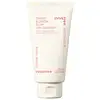What's inside
What's inside
 Key Ingredients
Key Ingredients

No key ingredients
 Benefits
Benefits

 Concerns
Concerns

 Ingredients Side-by-side
Ingredients Side-by-side

Water
Skin ConditioningGlycerin
HumectantSodium Cocoyl Alaninate
Disodium Cocoamphodiacetate
CleansingLauryl Hydroxysultaine
CleansingQuillaja Saponaria Bark Extract
CleansingPrunus Yedoensis Leaf Extract
Skin ConditioningBetaine
Humectant1,2-Hexanediol
Skin ConditioningAcrylates/C10-30 Alkyl Acrylate Crosspolymer
Emulsion StabilisingCaprylyl Glycol
EmollientSodium Chloride
MaskingCoco-Glucoside
CleansingSodium Cocoyl Isethionate
CleansingSodium Phytate
Propanediol
SolventHexylene Glycol
EmulsifyingCyanocobalamin
Skin ConditioningXanthan Gum
EmulsifyingParfum
MaskingWater, Glycerin, Sodium Cocoyl Alaninate, Disodium Cocoamphodiacetate, Lauryl Hydroxysultaine, Quillaja Saponaria Bark Extract, Prunus Yedoensis Leaf Extract, Betaine, 1,2-Hexanediol, Acrylates/C10-30 Alkyl Acrylate Crosspolymer, Caprylyl Glycol, Sodium Chloride, Coco-Glucoside, Sodium Cocoyl Isethionate, Sodium Phytate, Propanediol, Hexylene Glycol, Cyanocobalamin, Xanthan Gum, Parfum
Water
Skin ConditioningSodium Cocoyl Isethionate
CleansingDisodium Laureth Sulfosuccinate
CleansingLauryl Betaine
CleansingGlycerin
HumectantCoco-Glucoside
CleansingCoconut Acid
CleansingSodium Chloride
MaskingCapryloyl Salicylic Acid
ExfoliatingCitrus Tangerina Peel Extract
AstringentGlucosyl Hesperidin
HumectantDipropylene Glycol
HumectantPropanediol
SolventSodium Isethionate
CleansingDipotassium Glycyrrhizate
HumectantCaprylyl Glycol
EmollientPolyquaternium-10
Acrylates Copolymer
Tromethamine
BufferingHydroxyacetophenone
AntioxidantCitric Acid
BufferingDisodium EDTA
Water, Sodium Cocoyl Isethionate, Disodium Laureth Sulfosuccinate, Lauryl Betaine, Glycerin, Coco-Glucoside, Coconut Acid, Sodium Chloride, Capryloyl Salicylic Acid, Citrus Tangerina Peel Extract, Glucosyl Hesperidin, Dipropylene Glycol, Propanediol, Sodium Isethionate, Dipotassium Glycyrrhizate, Caprylyl Glycol, Polyquaternium-10, Acrylates Copolymer, Tromethamine, Hydroxyacetophenone, Citric Acid, Disodium EDTA
 Reviews
Reviews

Ingredients Explained
These ingredients are found in both products.
Ingredients higher up in an ingredient list are typically present in a larger amount.
Caprylyl Glycol is a humectant and emollient, meaning it attracts and preserves moisture.
It is a common ingredient in many products, especially those designed to hydrate skin. The primary benefits are retaining moisture, skin softening, and promoting a healthy skin barrier.
Though Caprylyl Glycol is an alcohol derived from fatty acids, it is not the kind that can dry out skin.
This ingredient is also used as a preservative to extend the life of products. It has slight antimicrobial properties.
Learn more about Caprylyl GlycolCoco-Glucoside is a surfactant, or a cleansing ingredient. It is made from glucose and coconut oil.
Surfactants help gather dirt, oil, and other pollutants from your skin to be rinsed away.
This ingredient is considered gentle and non-comedogenic. However, it may still be irritating for some.
Learn more about Coco-GlucosideGlycerin is already naturally found in your skin. It helps moisturize and protect your skin.
A study from 2016 found glycerin to be more effective as a humectant than AHAs and hyaluronic acid.
As a humectant, it helps the skin stay hydrated by pulling moisture to your skin. The low molecular weight of glycerin allows it to pull moisture into the deeper layers of your skin.
Hydrated skin improves your skin barrier; Your skin barrier helps protect against irritants and bacteria.
Glycerin has also been found to have antimicrobial and antiviral properties. Due to these properties, glycerin is often used in wound and burn treatments.
In cosmetics, glycerin is usually derived from plants such as soybean or palm. However, it can also be sourced from animals, such as tallow or animal fat.
This ingredient is organic, colorless, odorless, and non-toxic.
Glycerin is the name for this ingredient in American English. British English uses Glycerol/Glycerine.
Learn more about GlycerinPropanediol is an all-star ingredient. It softens, hydrates, and smooths the skin.
It’s often used to:
Propanediol is not likely to cause sensitivity and considered safe to use. It is derived from corn or petroleum with a clear color and no scent.
Learn more about PropanediolChances are, you eat sodium chloride every day. Sodium Chloride is also known as table salt.
This ingredient has many purposes in skincare: thickener, emulsifier, and exfoliator.
You'll most likely find this ingredient in cleansers where it is used to create a gel-like texture. As an emulsifier, it also prevents ingredients from separating.
There is much debate on whether this ingredient is comedogenic. The short answer - comedogenic ratings don't tell the whole story. Learn more about comegodenic ratings here.
The concensus about this ingredient causing acne seems to be divided. Research is needed to understand if this ingredient does cause acne.
Scrubs may use salt as the primary exfoliating ingredient.
Learn more about Sodium ChlorideSodium cocoyl isethionate is a natural ingredient from coconut oil. It is an ultra gentle cleanser that gives a nice foam without drying the skin or impacting the skin barrier.
The amount of foam created depends on the amount of sodium cocoyl isethionate used in the product.
This ingredient also helps improve the spreadability of a product.
Learn more about Sodium Cocoyl IsethionateWater. It's the most common cosmetic ingredient of all. You'll usually see it at the top of ingredient lists, meaning that it makes up the largest part of the product.
So why is it so popular? Water most often acts as a solvent - this means that it helps dissolve other ingredients into the formulation.
You'll also recognize water as that liquid we all need to stay alive. If you see this, drink a glass of water. Stay hydrated!
Learn more about Water